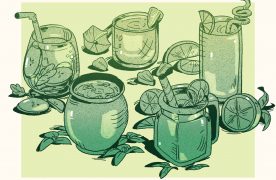When you ride the T, you’re surrounded by a multitude of different advertisements, from the more run-of-the-mill — ads for things like insurance companies and cell phones — to the more eye-catching — like the double entendres that Bernie & Phyl’s ads have become famous for. But there’s one product you won’t see an ad for anywhere on the T: alcohol. The MBTA has banned alcohol advertisements since 2012, and in the years since, several attempts have been made to reverse this policy.
On Monday, in an MBTA board meeting, officials pitched the idea yet again, saying that even limited alcohol advertising on the T could bring in $2.5 million a year. But the board wouldn’t budge — their primary concern being the influence these ads might have on youth.
What the board doesn’t seem to realize is that young people are far from free of advertisements for alcohol. On their way to the stop, they will undoubtedly pass by billboards, posters and TVs, all full of these kinds of ads. And even when they’re on the T, young people are more likely than not looking at their phones, where the influence of alcohol is abundant, rather than looking at the ads on the T itself.
Alcohol is so pervasive in our culture, and to think that banning it on the T would make any tangible difference is pretty shortsighted. It makes sense that the MBTA’s board of directors doesn’t want their business to be contributing to the problem, but this just doesn’t feel like the most important issue to tackle, or the most effective way to tackle it — especially when the MBTA is already facing a funding gap of $50 million this year.
If the T was already financially successful — if it ran smoothly, made money and heard very few complaints — then the board might have a stronger argument on this issue. But we all know this is not the case — not even close. The MBTA could badly use this extra revenue, and it could use the extra cash for things that could really help the people of Boston. An extra $2.5 million a year might help them extend the hours or broaden the reach of the MBTA.
So many people are not happy with the way the T is running, and here, the MBTA has the opportunity to try and change that — but if the board continues to ban advertisements for alcohol, they will be letting that go to waste.
The MBTA isn’t even arguing for a total takeover of alcohol ads on the T. The board actually proposed a number of different strategies for how to implement these ads with minimal exposure to youth — methods like not placing ads in stations that are popular among students, not advertising alcohol digitally during hours that more youth are online and using exterior ads rather than interior ones.
This is exactly the right way to go about this. It’s not an all or nothing issue — there is absolutely a way to integrate ads for alcohol into the T without having it affect students and young people too drastically. But even if it did, that probably wouldn’t be such a bad thing.
When we make alcohol such a taboo subject, we are ignoring the problem rather than addressing it, almost like having abstinence-only sex education in schools. Instead, we need to be talking about things that are potentially dangerous or inappropriate for younger audiences directly and honestly. In the case of the T, that doesn’t necessarily mean putting up ads that explain the risks of drinking — though that wouldn’t hurt — it would just mean ensuring the ads that do go up don’t encourage drinking in excess, or use sexist advertising strategies that are sometimes prevalent in ads for alcohol.
The cost-benefit analysis here is so straightforward. The MBTA can’t afford to turn down this kind of opportunity. Contrary to what their board of directors might think, integrating some limited advertising for alcohol on the T wouldn’t be the end of the world — in fact, it might do a lot of good.















When I was in Europe, I drank too much and had one-night stands.